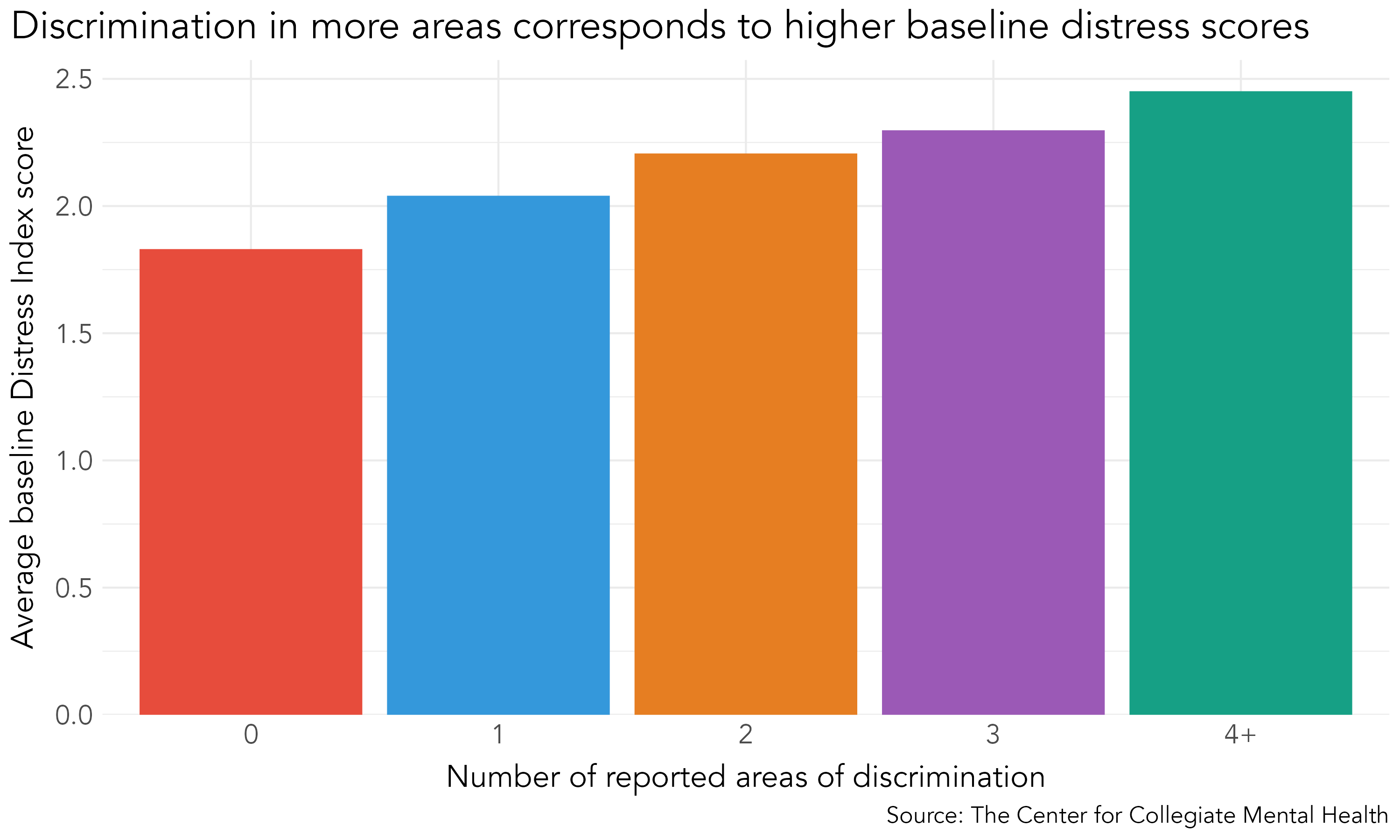The Relationship Between Experiences of Discrimination and Presenting Distress
In recent years, there has been increased attention on discrimination and its negative effects on well-being, including both physical and mental health. Students on university and college campuses are not immune from experiencing discrimination. According to data from the National College Health Assessment (NCHA), 7.9% of students experienced discrimination, and this rate is even higher in students who identify with minority identities.
The Center for Collegiate Mental Health (CCMH) conducts research aimed at understanding and improving college student mental health that specifically focuses on students seeking treatment at university and college counseling centers (UCCs). In an effort to further assess UCC clients’ experiences of discrimination when they enter services, CCMH added new items on the Standardized Data Set (SDS) in July 2021 that inquire whether they “experienced discrimination or unfair treatment due to any of the following parts of their identity” in the past six months: (1) disability; (2) gender; (3) nationality/county of origin; (4) race/ethnicity/culture; (5) religion; (6) and sexual orientation. In the current blog, the following questions were explored:
- What is the relationship between clients’ experience of discrimination and their level of presenting distress?
- What is the relationship between the specific types of discrimination and overall distress?
- When student clients report discrimination in multiple identity areas, is it associated with increased distress?
The data included in this blog represent 35,331 clients who sought services from 47 university and college counseling centers between July 1, 2021 and June 30, 2022. Items from the Standardized Data Set (SDS) and Counseling Center Assessment of Psychological Symptoms (CCAPS) subscales were utilized to answer the questions.
Overall, 19.4% of student clients reported discrimination related to at least one identity in the last 6 months. The graph below shows the percentage of total clients who endorsed the different areas of discrimination.

Question 1: What is the relationship between clients’ experience of discrimination and their level of presenting distress?
 Student clients who reported experiences of discrimination in the past six months, compared to those who did not, were substantially more distressed in all areas except Alcohol Use. Effect size differences were largest for the Distress Index (d = 0.38), Generalized Anxiety (d = 0.34), Frustration/Anger (d = 0.32), and Depression (d = 0.3).
Student clients who reported experiences of discrimination in the past six months, compared to those who did not, were substantially more distressed in all areas except Alcohol Use. Effect size differences were largest for the Distress Index (d = 0.38), Generalized Anxiety (d = 0.34), Frustration/Anger (d = 0.32), and Depression (d = 0.3).
Question 2: What is the relationship between the specific types of discrimination and overall distress?

Reported discrimination across all areas was associated with higher levels of distress on the Distress Index. Within the figure, the specific types of discrimination with the largest differences in overall distress between those reporting discrimination and not are displayed in descending order from the left to the right. Disability-related discrimination was associated with the greatest level of presenting distress, followed by Sexual Orientation and Nationality/Country of Origin-related discrimination. Effect size differences ranged from 0.66 for disability discrimination to 0.31 for race/ethnicity/culture discrimination, which represent meaningful differences in distress between clients with and without reported discrimination at intake.
Question 3: When student clients report discrimination in multiple identity areas, is it associated with increased distress?

Overall, 8% of all clients endorsed discrimination in at least 2 areas, indicating considerable intersectionality in the experience of discrimination. The figure above clearly demonstrates that distress levels increase as student clients report discrimination in more areas of their identity.
Summary and Implications
The following takeaways are noted:
- Overall, approximately 1 in 5 student clients (19.4%) reported discrimination in the past six months due to at least one part of their identity.
- Clients who reported any discrimination entered treatment, on average, with higher levels of distress across all areas, with the exception of Alcohol Use. The areas of distress that were associated with the largest increases were Generalized Anxiety, Frustration/Anger, and Depression.
- Although disability related discrimination was the most infrequently reported area of discrimination, it was associated with the highest levels of presenting distress, followed by Sexual Orientation and Nationality/Country of Origin-related discrimination.
- Overall distress increased as student clients reported multiple areas of discrimination, which demonstrates the potential effect of intersectional identities.
- Given these notable findings, it is essential for clinicians to further assess client concerns when they report any type of discrimination at the initiation of treatment. Additionally, if feasible, it is important for centers to consider implementing the CCMH discrimination items when students enter services. When clinicians are provided this information from their clients at the outset of services, it can greatly inform their assessments and subsequent care plan.
- Treatment at college counseling centers can be helpful for student clients who have experienced discrimination. However, discrimination itself is not a mental health problem nor should the response to this significant issue primarily land in the mental health realm. Rather, it is incumbent upon colleges and universities to address discrimination and its impact at all levels of the institution in order to effectively identify, manage, protect against, and provide support for this ongoing societal problem.

